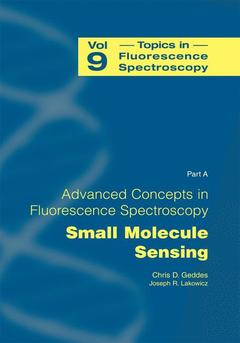Description
Advanced Concepts in Fluorescence Sensing, 2005
Part A: Small Molecule Sensing
Topics in Fluorescence Spectroscopy Series, Vol. 9
Coordinators: Geddes Chris D., Lakowicz Joseph R.
Language: English
Subjects for Advanced Concepts in Fluorescence Sensing:
Keywords
RNA; biology; biotechnology; fluorescence; protein; Biological Microscopy
Publication date: 12-2014
327 p. · 17.8x25.4 cm · Paperback
Publication date: 06-2005
327 p. · 16.5x24.8 cm · Hardback
Description
/li>Contents
/li>Comment
/li>
Over the last decade, fluorescence has become the dominant tool in biotechnology and medical imaging. These exciting advances have been underpinned by the advances in time-resolved techniques and instrumentation, probe design, chemical / biochemical sensing, coupled with our furthered knowledge in biology.
Complementary volumes 9 and 10, Advanced Concepts of Fluorescence Sensing: Small Molecule Sensing and Advanced Concepts of Fluorescence Sensing: Macromolecular Sensing, aim to summarize the current state of the art in fluorescent sensing. For this reason, Drs. Geddes and Lakowicz have invited chapters, encompassing a broad range of fluorescence sensing techniques. Some chapters deal with small molecule sensors, such as for anions, cations, and CO2, while others summarize recent advances in protein-based and macromolecular sensors. The Editors have, however, not included DNA or RNA based sensing in this volume, as this were reviewed in Volume 7 and is to be the subject of a more detailed volume in the near future.
While many of the changes in recent fluorescence have been well-received, its continued growth in the world has created a challenge in trying to archive and document its use.
Subsequently Chris D. Geddes has now become co-series editor of the Topics in Fluorescence Spectroscopy series.
Geddes and Lakowicz have also recently launched the Reviews in Fluorescence series, which is published annually and meant to compliment the Topics in Fluorescent Spectroscopy series, with small chapters summarizing the yearly progress in fluorescence
These books may interest you

Glucose Sensing 158.24 €



